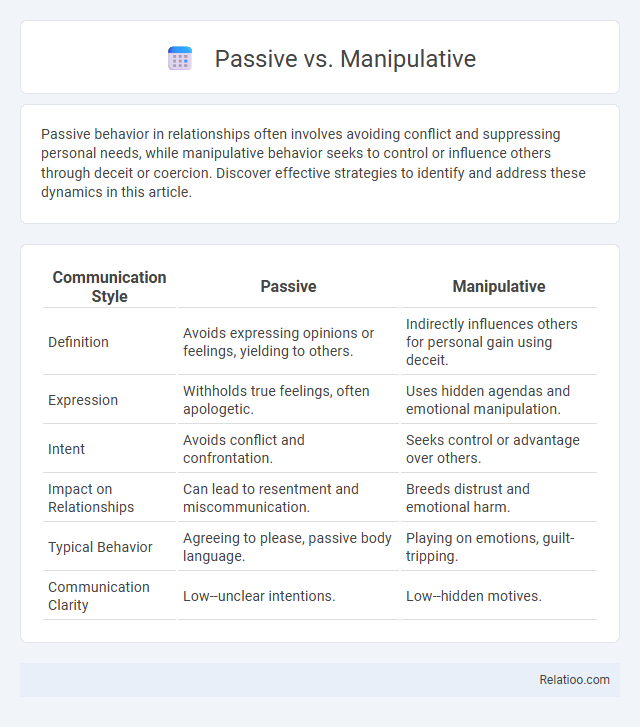Passive behavior in relationships often involves avoiding conflict and suppressing personal needs, while manipulative behavior seeks to control or influence others through deceit or coercion. Discover effective strategies to identify and address these dynamics in this article.
Table of Comparison
| Communication Style | Passive | Manipulative |
|---|---|---|
| Definition | Avoids expressing opinions or feelings, yielding to others. | Indirectly influences others for personal gain using deceit. |
| Expression | Withholds true feelings, often apologetic. | Uses hidden agendas and emotional manipulation. |
| Intent | Avoids conflict and confrontation. | Seeks control or advantage over others. |
| Impact on Relationships | Can lead to resentment and miscommunication. | Breeds distrust and emotional harm. |
| Typical Behavior | Agreeing to please, passive body language. | Playing on emotions, guilt-tripping. |
| Communication Clarity | Low--unclear intentions. | Low--hidden motives. |
Understanding Passive Behavior
Passive behavior involves avoiding confrontation and suppressing personal needs to maintain harmony, often leading to unexpressed feelings and resentment. Manipulative behavior seeks to influence others covertly to achieve personal goals, frequently at the expense of honesty and transparency. Understanding passive behavior requires recognizing its roots in fear of conflict and low self-esteem, which contrast with manipulators' strategic control and assertive individuals' direct communication.
Defining Manipulative Actions
Manipulative actions involve covertly influencing others' behavior or decisions to serve one's own interests, often at the expense of honesty or transparency. Unlike passive behavior, which is characterized by inaction or avoidance, and assertive behavior, which involves clear and direct communication, manipulative actions rely on deceit, exploitation, or subtle persuasion techniques. Understanding manipulative tactics, such as guilt-tripping, gaslighting, or emotional exploitation, is essential for recognizing and responding to these behaviors in interpersonal relationships.
Key Differences Between Passive and Manipulative Tactics
Passive tactics involve avoiding conflict and expressing feelings indirectly, while manipulative tactics seek to control or influence others covertly to achieve personal goals. Key differences between passive and manipulative behaviors lie in intent and transparency: passive individuals often prioritize maintaining peace without confrontation, whereas manipulative individuals intentionally use deception or guilt to sway others. Understanding these distinctions helps your communication become more authentic and assertive.
Psychological Roots of Passivity
Passivity often stems from deep psychological roots such as fear of conflict, low self-esteem, or a history of learned helplessness, which can trap Your decision-making and reduce assertiveness. Manipulative behavior arises when an individual uses subtle control tactics to influence others, often masking vulnerability or insecurity behind strategic actions. Understanding these distinctions is crucial to addressing the underlying emotional causes and fostering healthier communication patterns.
Motivations Behind Manipulative Behavior
Manipulative behavior is driven primarily by a desire for control, power, or personal gain, often at the expense of others, distinguishing it from passive behavior where individuals typically avoid conflict and assertiveness. Passive individuals tend to suppress their own needs to maintain harmony, while manipulative individuals actively influence or deceive others to achieve hidden objectives. Understanding these motivations highlights the contrast between avoiding confrontation and exploiting situations for self-interest.
Common Signs of Passive Communication
Common signs of passive communication include avoiding eye contact, speaking softly or hesitantly, and consistently yielding to others' opinions even when they conflict with Your own. Individuals who use passive communication often struggle to assert their needs or express dissatisfaction, leading to unresolved issues and internal resentment. Recognizing these behaviors can help differentiate passive communication from manipulative or aggressive interactions and foster healthier dialogue.
Common Signs of Manipulation
Common signs of manipulation include persistent guilt-tripping, twisting facts to create confusion, and exploiting emotional vulnerabilities to control behavior. Manipulative individuals often use passive-aggressive tactics, such as silent treatment or subtle sabotage, to influence others without direct confrontation. These behaviors contrast with passive personalities, who typically avoid conflict and assertiveness, whereas manipulative actions aim to dominate and exploit relationships for personal gain.
Impact on Relationships: Passive vs Manipulative
Passive behavior often leads to frustration and resentment in relationships due to unmet needs and lack of clear communication. Manipulative actions can severely damage trust and create patterns of control, leading to emotional harm and instability. Understanding these distinctions helps in fostering healthier interactions and promoting mutual respect.
How to Respond to Passive and Manipulative Individuals
When responding to passive individuals, maintain clear communication by setting firm boundaries and encouraging assertiveness to prevent misunderstandings. In interactions with manipulative individuals, recognize and label their tactics calmly while reinforcing your limits and avoiding emotional reactions that may empower their behavior. Prioritizing direct, respectful responses limits the influence of both passive and manipulative behaviors and promotes healthier, more balanced relationships.
Fostering Healthy Communication Alternatives
Fostering healthy communication alternatives involves recognizing the differences between passive, manipulative, and assertive behavior to improve interactions. Passive communication often ignores your needs, while manipulative tactics aim to control or deceive others, undermining trust and respect. Embracing assertive communication helps you express your thoughts and feelings clearly and respectfully, promoting mutual understanding and stronger relationships.

Infographic: Passive vs Manipulative
 relatioo.com
relatioo.com